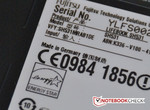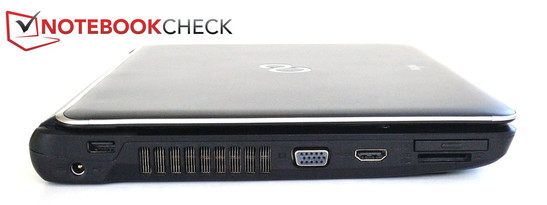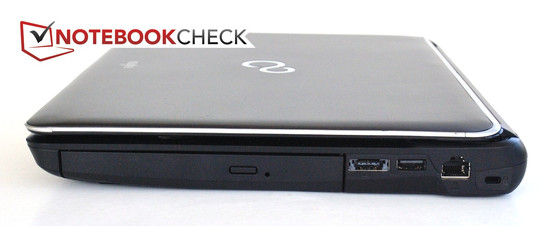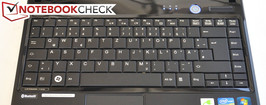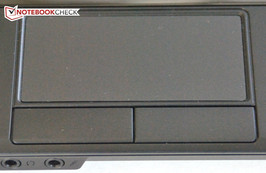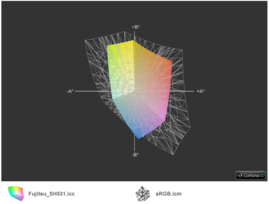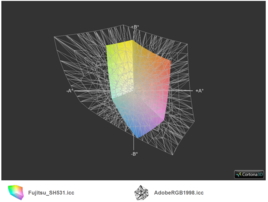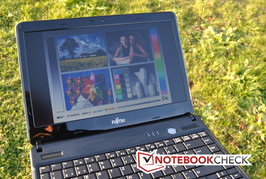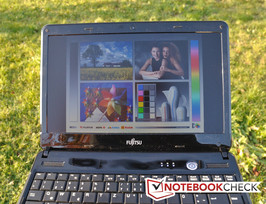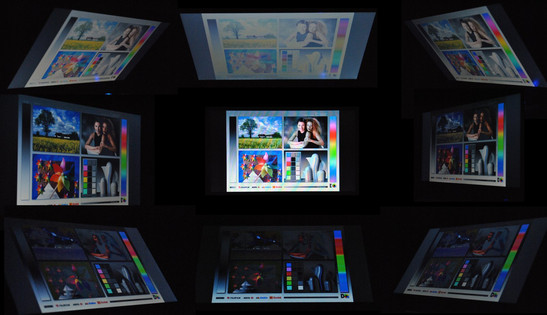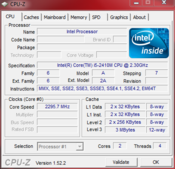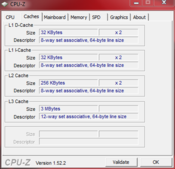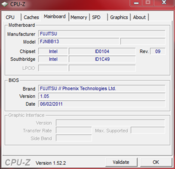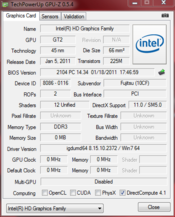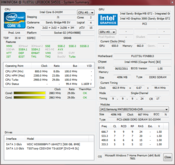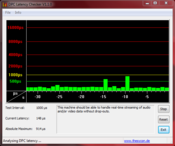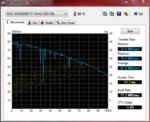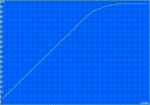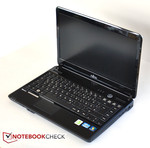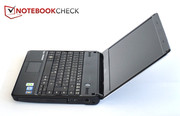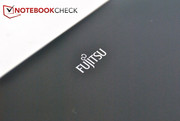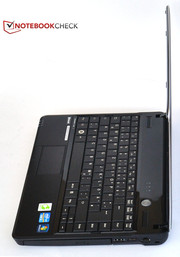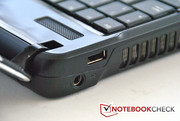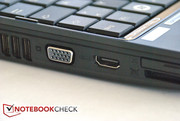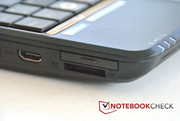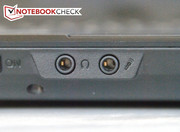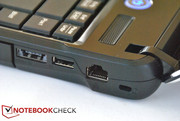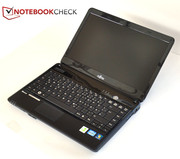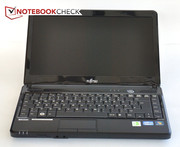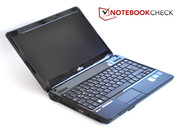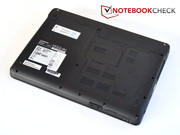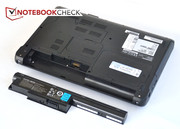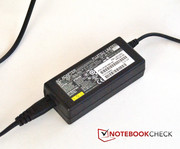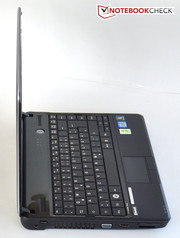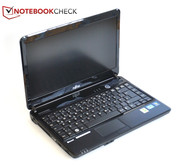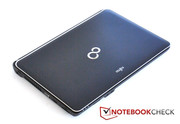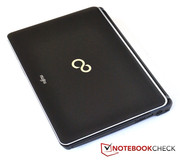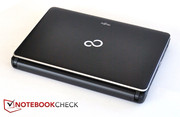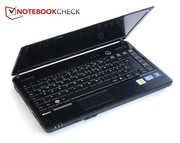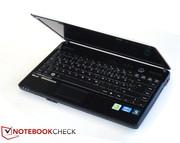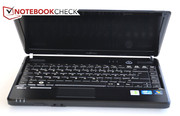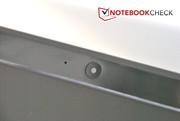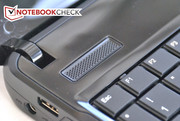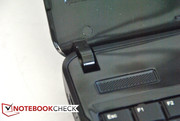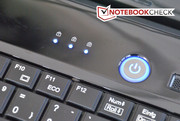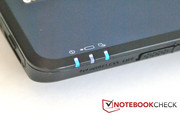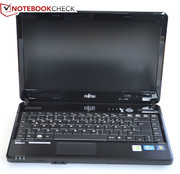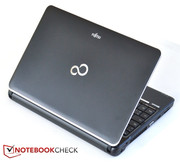Review Fujitsu LifeBook SH531 Subnotebook
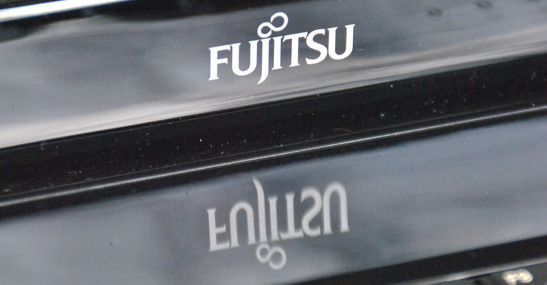
The Fujitsu Lifebook SH531 originates from the Lifebook range that has been conceived for consumers, small businesses and the self-employed. It is the successor of the Lifebook SH530 and the little brother of the 14 inch LH531 and 15 inch AH531. At a price of only 550€, the SH531 would sooner like to find buyers looking around in a lower price range. However, the specs don't sound particularly interesting. An Intel Core i5 2410M is found in virtually every third subnotebook and the processor-embedded graphics card, Intel HD Graphics 3000, won't knock anyone's socks off either. But they fit well into a compact office device.
Fujitsu is an extraordinary manufacturer, because it advertises with Japanese and German quality. Formerly in cooperation with Siemens, Fujitsu still develops and produces in Germany. Therefore, a label is found on the bottom of Lifebooks that is very rare: Made in Germany. The Lifebook has actually been built in Aachen. Of course, not all parts are produced there. But it's where the mainboards are produced and the final assembly is carried out.
Now the question arises: Will the Fujitsu laptop also become popular among German customers?
Case
The Fujitsu SH531 is a bit bulky and, unfortunately, also looks a bit cheap on the whole. In terms of design, it looks a lot like its bigger brother, the Fujitsu Lifebook LH531. In contrast to the previous SH530, which was on the market in a glaring red aluminum case, the Lifebook SH531 is only available in dark gray and is therefore unobtrusive. The display lid is made of a dark gray, matt plastic and looks quite elegant. A silver colored border sets accents. Black plastic has been applied to the laptop's bottom and sides.
Disappointment follows when the subnotebook is opened. The user will have to live with high-gloss surfaces around the screen and the keyboard. They smudge quickly and consequently have to be polished frequently. Apart from that, the glossy plastic makes a cheap and inappropriate impression. The power button is fairly large and is illuminated in blue. The three status LEDs on the left front light up in the same color.
The Fujitsu isn't exactly thick with a height of 35 mm, but it looks a bit bulky due to the rounded corners and the thin display. The weight of 2 kg, including the battery, is average for this category.
The notebook's stability is acceptable. The display lid can hardly be warped. Slight color deviations are created when pressure is applied to the back of the display. The hinges are sufficiently strong and can still keep the display fairly well in place during moderate movements. Unfortunately, it's not possible to open the laptop with one hand because the base unit also lifts along. The notebook's surface can be dented a bit almost everywhere. Merely the strip between the keyboard and screen is very robust.
Connectivity
The Lifebook is quite well equipped for its price range. Although there is no USB 3.0, data can be quickly copied via the eSATA interface. It has been combined with a USB 2.0 port. Two additional USB 2.0 ports are located on the right and left rear side. The standardly installed Ethernet and VGA ports are also available. HDMI is found on the left beside the 4in1 card reader (SD/MMC/MS/MS-PRO). An ExpressCard 34mm has been placed above it. A headphone or microphone/line-in can be connected at the front.
The interface distribution on the right is suitable for using an external mouse. The ports have been all built into the rear area because of the DVD drive. In contrast, connected VGA or HDMI cables need a lot of room on the Lifebook's left. All ports are have enough space to one another so that plugs won't interfere with each other.
Communication
Fujitsu provides the Lifebook SH531 with the three most common communication technologies: Gigabit LAN, WLAN b/g/n and Bluetooth v1.2. There is no UMTS module, but that can't be expected in this price range anyway.
Software
The user will find several preinstalled tools on the Lifebook. However, most of their options are just as available in the Windows 7 functions. Merely the Fujitsu LaunchCenter proves to have convenient functions such as creating recovery DVDs and automatic updates.
Warranty
The warranty is limited to a one year bring-in service. This means that the notebook has to be brought to the seller or sent directly to Fujitsu in case of a warranty claim.
Input Devices
Keyboard
Fujitsu hasn't installed a chiclet-style keyboard as it's currently fashionable. The keys are thus closer together, but the sides are beveled. Though it looks strange at first, it successfully prevents two keys from being pressed at the same time. The key drop isn't very deep, but touch typing also works well due to a clear feedback. The keyboard isn't suitable for gamers because of the narrow arrow keys, but they aren't the laptops target group anyway.
Three blue LEDs next to the power button above the keyboard show if any lock keys have been pressed. The spec sheet promises that the keyboard is spill-proof.
Touchpad
The touchpad is very small with a size of only 74x35 mm. Even subnotebooks should bid a bit more surface for navigating. The multi-touchpad comes from Synaptics and can handle all usual multi-touch functions. The touchpad doesn't always respond at its lower edge. However, that is rarely perceived as interfering. The mouse keys work well, but only have a short drop as well as only a low pressure point.
Display
The 13 inch screen has a native resolution of 1366x768 pixels. It is produced by LG and has the model number LP133WH2-TLM3. The Lifebook has a big advantage over other laptops in the low-end price range: A matt screen. It prevents reflections that would otherwise be very annoying in a bright surrounding.
Fujitsu optimistically specifies a brightness of 220 cd/m2 on its spec sheet. However, we don't measure this rate anywhere on the screen. With a maximum of 215 cd/m2 in the upper center, the screens luminosity remains just below that of what is actually advertised. The brightness declines a bit toward the bottom and the sides, and the Lifebook reaches an average brightness of 195 cd/m2 with only 182 cd/m2 on the left center.
Subjectively, the screen looks pallid and colorless in bright surroundings. For example, we still measure a high 1.42 cd/m2 on a black screen. This results in a weak maximum contrast of only 146:1.
This is still acceptable for office applications, but multimedia content (pictures, videos, etc.) clearly lose in quality.
| |||||||||||||||||||||||||
Brightness Distribution: 85 %
Center on Battery: 208 cd/m²
Contrast: 146:1 (Black: 1.42 cd/m²)
37.49% AdobeRGB 1998 (Argyll 3D)
53.6% sRGB (Argyll 3D)
36.13% Display P3 (Argyll 3D)
As expected from a low-cost screen, the LG screen doesn't come close to covering the sRGB color spectrum, not to mention the far more demanding AdobeRGB. But this shouldn't be particularly significant in an office device. Only professional photographers or graphic designers require a well-covered color space.
The SH531 can hold its own quite well in radiant sunlight. It's possible to still see everything well even in bright surroundings thanks to the anti-reflective screen. Only the colors don't come into their own because of the weak brightness. Nevertheless, the notebook is quite suitable for working outdoors.
As common for an office laptop, the screen's viewing angles aren't particularly good. The screen remains legible during horizontal rotations, but the colors already fade or invert. The colors change extremely and get dark when the screen is tilted toward the back. The display does a better job when tilted forward. Colors can still be recognized as such despite intense dimming.
Performance
The currently very popular Intel Core i5 2410M processor is built into the Fujitsu Lifebook SH531. All kinds of office applications can be easily executed with it. Editing a picture or a short video isn't a problem for this CPU. The subnotebook only has to surrender in demanding computer games. The latter is especially due to the graphics card that is embedded into the processor and which isn't made for demanding 3D tasks.
Beyond that, a fast, 4GB DDR3 RAM has been installed. It is supported by a 500 GB hard disk from Western Digital that rotates with 5400 revolutions per minute. The hard disk isn't made for very large throughputs, but is quieter and saves energy in contrast to faster 7200 rpm HDDs. The optimum would be a solid state drive because it is noiseless, energy efficient and fast. However, they are not used in this price range.
Processor
The processor is loaded and its performance capacity is tested in various renderings in the Cinebench runs. The Lifebook scores quite well here. It doesn't excel its rivals that have the same processor, but the laptop doesn't fall far behind either. Thus, the subnotebook is on a par with the Vostro 3350 subnotebook from Dell and its bigger brother, the Lifebook LH531.
System Performance
The subnotebook's system is assessed as a whole in PCMark Vantage. Here, several factors are considered which give a comparative figure in the end. It attempts to provide a practically relevant result by simulating tasks as realistic as possible. For example, the speed at which images can be changed or videos can be watched is measured, as well as the time that is needed to display a website.
The Lifebook's performance again is in the mid field here. It doesn't stick out anywhere, but doesn't lag far behind, either. With 5901 points, the SH531 significantly lags behind the Vostro 3350 due to its weaker hard disk. However it can keep up well with its big brother, the LH531, which only has a one point lead on the SH531.
| PCMark Vantage Result | 5901 points | |
| PCMark 7 Score | 2133 points | |
Help | ||
Mass Memory
A WD5000BPVT-16HXZT2 hard disk from Western Digital is built-in. It has a gross capacity of 500 GB. However, only about 450 GB are left after formatting and deducting the system recovery space. The specified 5400 rpm doesn't let us expect any record breaking feats, and the hard disk is located in the midfield. However, an average transfer rate of 62.6 MB/s and an access speed of 21.1 ms is easily beaten even by other conventional disks. An SSD isn't even needed for that.
Graphics Solution
The Lifebook has to use the processor-embedded Intel HD Graphics 3000 for calculating video output because it lacks a dedicated graphics card. It is fully sufficient for HD videos and older computer games. The settings only have to be reduced massively for demanding games in order to play them smoothly.
The 3DMark tests run multiple renderings and evaluate the graphics performance. Here, the Fujitsu LifeBook is on a par with other notebooks equipped with an Intel i5 2410M and HD Graphics 3000.
| 3DMark 03 Standard | 7726 points | |
| 3DMark 05 Standard | 5931 points | |
| 3DMark 06 Standard Score | 3263 points | |
| 3DMark Vantage P Result | 1575 points | |
Help | ||
Emissions
System Noise
The Lifebook's emissions score is something of a mixed bag. The system noise is consistently good. The notebook is hardly audible in idle or during light office load. The quiet DVD drive is a highlight, since a loud noise would be annoying when watching a movie. That is unfortunately the case with other devices.
The fan of course increases its speed during full load. Nevertheless, it doesn't reach any interfering rates with a maximum of 38 dB.
Noise level
| Idle |
| 29.1 / 30 / 32.9 dB(A) |
| HDD |
| 30.3 dB(A) |
| DVD |
| 32.8 / dB(A) |
| Load |
| 36.5 / 38 dB(A) |
 | ||
30 dB silent 40 dB(A) audible 50 dB(A) loud |
||
min: | ||
Temperature
Regrettably, the impression isn't as positive in heat development. The notebook's temperature is more than lukewarm in various places in idle. While this isn't particularly disturbing in idle, it is under load. The Lifebook reaches up to 45°C on the bottom's rear. A thick laptop with this performance should really perform better here. Anyway, this won't be a problem in conventional office tasks and the device can also be used on the lap.
Stress Test
The slow turning fan keeps the laptop quiet, but can't prevent it from getting fairly warm during load. Thus, it will be interesting to find out whether the cooling is sufficient or not in our stress test. We load both the graphics card and the processor to full capacity for over an hour. We also monitor if the processor's Turbo Boost is enabled. In some laptops, the CPU is throttled down to the base clock or sometimes even below 1 GHz after a time because of imminent overheating.
The surprising result was presented an hour later: The processor cores didn't exceed 80°C and ran stably on the i5 2410M's maximum clock of 2.7 GHz. That is a very good feat for a subnotebook.
(+) The maximum temperature on the upper side is 32.7 °C / 91 F, compared to the average of 35.9 °C / 97 F, ranging from 21.4 to 59 °C for the class Subnotebook.
(±) The bottom heats up to a maximum of 44.9 °C / 113 F, compared to the average of 39.3 °C / 103 F
(+) In idle usage, the average temperature for the upper side is 28.2 °C / 83 F, compared to the device average of 30.8 °C / 87 F.
(+) The palmrests and touchpad are cooler than skin temperature with a maximum of 30.3 °C / 86.5 F and are therefore cool to the touch.
(-) The average temperature of the palmrest area of similar devices was 28.2 °C / 82.8 F (-2.1 °C / -3.7 F).
Speakers
The speakers aren't suitable for multimedia applications. The stereo speakers can only render system sound sufficiently. As common, there is absolutely no bass in music. But the trebles also distort quickly and the entire sound seems very flat. Apart from that, the speakers' volume is very low so that external speakers are definitely required in presentations with sound.
Battery Life
Power Consumption
Fujitsu states that the Lifebook's power consumption is particularly "green". And in fact, the consumption of about 10 watts is very low due to the processor's energy saving measures. The processor can clock down to 800 MHz when idle and is thus energy efficient. The graphics solution also only needs little power since it's embedded into the processor and a dedicated chip doesn't have to be supplied with energy.
We measured the minimum power consumption of only 7.6 watts with a dark screen and disabled WLAN. The screen's brightness was set to the maximum for the other measurements.
The Windows 7 preset energy saving mode "Balanced" was selected for assessing the medium power consumption in idle. The notebook still achieves a good rate of just below 10 watts. The laptop needs a lot more while running 3DMark. However, 42 watts aren't too much either.
| Off / Standby | |
| Idle | |
| Load |
|
Key:
min: | |
Battery Life
A 48 Wh lithium ion battery is built into the Lifebook SH531. The subnotebook lasts up to 6 hours and 18 minutes although the battery's capacity isn't excessively big. However, this rate is only reached when all energy saving options are enabled. It is determined by the BatteryEater Reader's test that simulates reading a text document.
Our WLAN surf test is far more realistic because we surf on the Internet via WLAN with adapted brightness. The Lifebook lasts for 3 hours and 50 minutes in this case. This should be perfectly sufficient for most users.
Those who would like to watch a movie on the laptop can rely on the notebook when the battery is fully charged. The battery runtime of a bit more than 3 hours should be absolutely sufficient for most movies. It's even possible to just still watch Lord of the Rings - The Return of the King without an interruption.
The subnotebook lasts for 1 hour and 17 minutes in load. The notebook is loaded to capacity by BatteryEater's Classic test which renders a moving 3D object. The CPU's performance is slightly reduced in Cinebench R11.5 in battery mode, but only from 2.59 to 2.46 points. The lack of mains power has a slightly negative impact on the system's performance.
The battery needs a bit more than two hours for recharging.
Verdict
The Fujitsu Lifebook SH531 leaves mixed feelings. It starts with its design: While the subnotebook looks elegant and business-like on the outside, it gleams with smudge-prone consumer surfaces inside. The stability and workmanship is satisfactory, but not especially outstanding.
Unfortunately, a USB 3.0 port isn't included among the ports. In return, the user gets an eSATA port and ExpressCard 34 mm slot. The keyboard convinces, even if it doesn't follow the current chiclet-style trend. On the other hand, the touchpad is very small and could have used a bit more room.
The screen is matt, but fairly dark and has tight viewing angles. Fujitsu could have definitely built in something better here. But it likely made cutbacks here in favor of a low price. Nevertheless, the subnotebook can still be used well outdoors. The performance is adequate and will be fully sufficient for most users. The Lifebook just isn't suitable for games due to the lack of a dedicated graphics card.
The SH531 also scores well in the emission rates: The notebook is barely audible in idle and even stays discreetly in the background when the DVD drive is used. Moreover, the notebook only needs little energy and can therefore last for almost 4 hours without a power outlet when surfing on the Internet.
The Lifebook SH531 can be placed on the shortlist when looking for a low-priced subnotebook with up to date equipment for little money. Although it doesn't stick out with its throughout good qualities, Fujitsu hasn't made any major flaws either.




